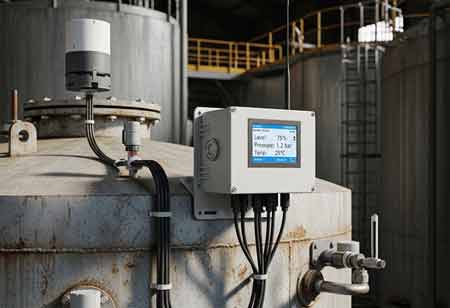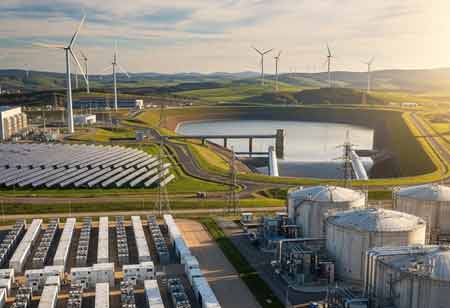CLOSE
Specials
I agree We use cookies on this website to enhance your user experience. By clicking any link on this page you are giving your consent for us to set cookies. More info
Be first to read the latest tech news, Industry Leader's Insights, and CIO interviews of medium and large enterprises exclusively from Energy Tech Review
Thank you for Subscribing
Cybersecurity in Tank Monitoring: Safeguarding Critical Infrastructure
The shift to digital tank monitoring enhances efficiency but introduces cybersecurity risks, requiring multi-layered defenses, strong access controls, and ongoing employee training to safeguard critical infrastructure.

By
Energy Tech Review | Tuesday, September 09, 2025
Stay ahead of the industry with exclusive feature stories on the top companies, expert insights and the latest news delivered straight to your inbox. Subscribe today.
Fremont, CA: Today, where technology plays a pivotal role in nearly every industry, traditional methods of monitoring essential infrastructure are being replaced by advanced digital solutions. Tank monitoring, in particular, has evolved from manual, on-site inspections to remote, automated systems that provide real-time data. While this shift offers significant benefits in terms of efficiency, accuracy, and cost savings, it also introduces new vulnerabilities. As these systems become more integrated with corporate networks and the internet, the need for robust cybersecurity measures becomes paramount.
Safeguarding Critical Infrastructure
To effectively mitigate cybersecurity risks, organizations must adopt a comprehensive, multi-layered approach that integrates technological safeguards, procedural controls, and human awareness. One critical strategy is network segmentation, which ensures that tank monitoring systems remain isolated from the corporate network, preventing breaches in one domain from compromising operational technology (OT) systems. Equally important is the enforcement of strong authentication and access control, including multi-factor authentication (MFA) and role-based access control (RBAC), to restrict system access strictly to authorized personnel. Regular audits and vulnerability assessments, such as penetration testing and security reviews, are also essential for proactively identifying and addressing weaknesses before they can be exploited. To secure data integrity, organizations should implement robust encryption protocols for all transmissions between sensors, telemetry units, and central monitoring platforms, safeguarding against unauthorized interception or tampering. Advanced intrusion detection and prevention systems (IDPS) add another layer of defense by continuously monitoring network activity, blocking malicious traffic, and alerting administrators to potential threats. Employee training and awareness programs play a vital role, as human error remains a leading cause of breaches. Equipping staff with knowledge on recognizing phishing attempts and following cybersecurity best practices can significantly reduce these risks. A clearly defined incident response plan is indispensable, outlining the procedures for containment, recovery, communication, and collaboration with law enforcement in the event of an attack.
The Future of Cybersecurity for Tank Monitoring
The cyber threat landscape is constantly evolving, requiring organizations to adapt and strengthen their defensive strategies continually. Attackers are increasingly leveraging artificial intelligence (AI) and machine learning (ML) to automate attacks and craft compelling social engineering campaigns. At the same time, these technologies are playing a critical role in defense, enabling automated threat detection and anomaly monitoring. AI-powered systems can process vast volumes of data from sensors and network traffic to uncover suspicious patterns that may go undetected by human analysts.
In parallel, the adoption of Zero Trust Architecture (ZTA) has become essential, as the traditional perimeter-based security model is no longer sufficient. Built on the principle of “never trust, always verify,” Zero Trust requires every user, device, and application—regardless of location—to be authenticated and authorized before gaining access to resources.
Equally important is supply chain security. Tank monitoring systems often rely on hardware and software sourced from multiple vendors, creating potential vulnerabilities at various points in the supply chain. A compromised sensor component or a malicious software update could introduce significant risks. Proactive supply chain risk management is therefore a fundamental pillar of any robust security framework.
As tank monitoring systems generate increasingly large volumes of data, reliance solely on cloud processing can create latency and bandwidth challenges. Edge computing addresses these issues by enabling data processing closer to the source, such as directly on monitoring devices. Beyond performance benefits, this approach enhances security by allowing devices to detect and respond to threats in real-time, while reducing dependence on a centralized server that could otherwise represent a single point of failure.
The integration of technology into tank monitoring has ushered in an era of unprecedented efficiency and control. However, it has also introduced a new set of risks that cannot be ignored. The consequences of a cyber-attack on this critical infrastructure can be severe, making robust cybersecurity a non-negotiable part of any modern tank monitoring system. By adopting a comprehensive, multi-layered approach that combines advanced technology, strict protocols, and continuous training, organizations can protect their assets, ensure operational continuity, and safeguard the environment from the growing threat of cybercrime. The future of tank monitoring is digital, but its security must be a priority today.

Copyright © 2025 Energy Tech Review. All rights reserved






